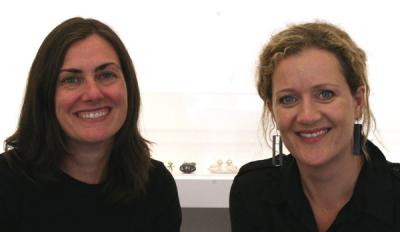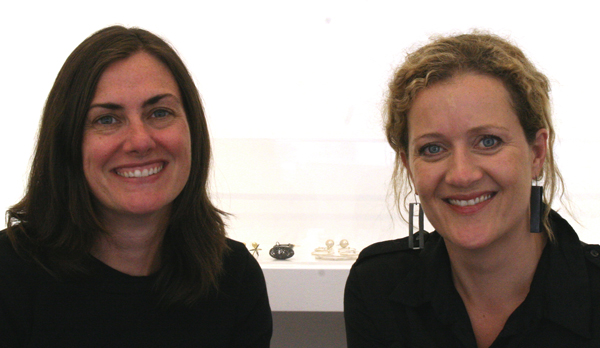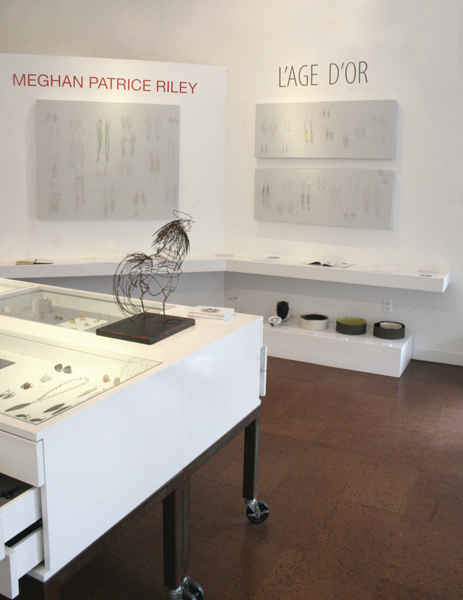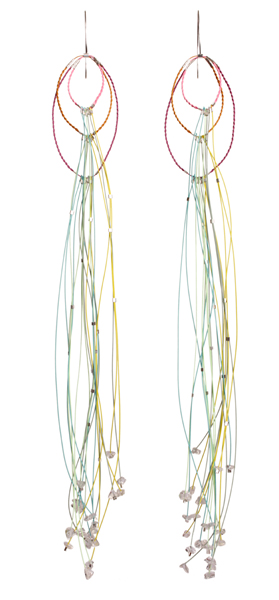
Susan Cummins: Karen, can you tell us the story of how you became a jeweler and then a gallery owner? What is your training?
Karen Gilbert: I started as a painting major in school at The California College of the Arts, but while taking a metal class as an elective I fell in love with working with my hands in metal. It was very natural act that felt so comfortable. I was also educated in glass and glass blowing and that has woven itself into my career as well. After school, I had worked as a jewelry designer/artist for years and then it became necessary to make a living at it. At that point, I went from an artistically free period to the necessity of making a living.

Susan Cummins: Karen, can you tell us the story of how you became a jeweler and then a gallery owner? What is your training?
Karen Gilbert: I started as a painting major in school at The California College of the Arts, but while taking a metal class as an elective I fell in love with working with my hands in metal. It was very natural act that felt so comfortable. I was also educated in glass and glass blowing and that has woven itself into my career as well. After school, I had worked as a jewelry designer/artist for years and then it became necessary to make a living at it. At that point, I went from an artistically free period to the necessity of making a living.
Creating a viable income source for myself through my work made the concept of the saleability of jewelry very interesting to me. Why do people fall in love with a piece enough to buy it and take it home? This interest along with the desire to see my work shown in a better light led me to the idea of a gallery. Healdsburg was chosen because of the beauty of location for our family, along with potential built-in clientele for a gallery. Luckily I met Katrina, who also had passion for art as well as seeing the potential for a Healdsburg gallery and we really needed each other. I had the contacts and information on curating for the artists, Katrina had the ability to manage and oversee the vision. Katrina has a background in literature, along with a natural passion for art. Having worked in the art world in both Europe and the United States, her Danish heritage and experience growing up in Africa give her an informed perspective which she brings directly to Gallery Lulo

Karen Gilbert: Lulo has been open for just over three years.
I understand that you have started another business as well called SKLO. Do you want to describe that as well?
Karen Gilbert: Through the gallery I met our SkLO business partner, Pavel Hanousek, who imports Czech glass from master glass artists in the Czech Republic. The aesthetics of his business were in desperate need of updating. My husband and I joined him, re-branded the business and now are owners and designers of a glass-based design company. It has been a fascinating challenge approaching work as a designer instead of as the maker. What I love about SkLO is being able to work within one of the world’s great craft traditions – Czech glassblowers – yet having the freedom to make work that does not put technical skill before overall concept and design. Along with my husband, Paul Pavlak, I have the opportunity to sculpt the entire vision of the company. It is a huge challenge that involves business savvy as well as creativity. SkLO is successfully growing and is finding a receptive market and critical acclaim. We show some of the SkLO glass work at Gallery Lulo as well.
Right now you have a lovely small space in Healdsburg and you mentioned that you are going to expand. Are you moving? Please describe what is happening.
Karen Gilbert: We have acquired the space next to us and plan to expand on the current vision. We will use the space next door as a temporary exhibition space until the winter, then renovate both, linking the two together. The expansion and the relationship between the combined spaces will allow for us to expand on our current jewelry display and exhibition space while simultaneously giving us a dedicated place to show larger art works.

Karen Gilbert: We look for a wide variety of approaches to material and wearability, but within an aesthetic that appeals to both of us. We want to be passionate about what we sell – we want it to move us. When we started Gallery Lulo, it was anchored around my work and since then we have drawn from the raw yet light and delicate sensibility of my work to create a direct thread to our aesthetic vision for the space. That vision encompasses the elements of experimentation, organic abstraction and visually re-conceptualizing our modern condition. The gallery experience should challenge yet invite the viewer to want to go further on their journey with us.
Between running a the gallery, starting SKLO, making jewelry yourself, consigning work with other galleries and expanding your space, plus taking care of your family, I can’t imagine how you have the energy to do it all. What is the secret to your energy? Are you on a special diet?!
Karen Gilbert: It has been crazy to say the least. I love a challenge and I honestly could not ask for more. I have had to streamline my personal jewelry work down to working with a core group of galleries. I am working toward making the jewelry a passion and art form again, instead of something that is both a love and a means of survival. My week has a strict schedule – when I am working I work non-stop and when I am done it is time for my family. There is not a lot in-between. Because of SkLO, the last few years have included a great deal of travel, but we take our daughter along with us. She loves traveling and has seen the world by the age of four. I vary the intensity between the three businesses, some months I hardly get into the studio and am focused on the gallery, while others are all about SkLO. I try to take advantage of down times in the different businesses to create a balance. I have a great group of people working alongside me, especially with Gallery Lulo. Katrina’s passion for the gallery is equal to my own and that makes it work. I could not do it alone. Also, in the studio I have a couple of great assistants and at SkLO we have a whole team to depend on.
Thanks Karen. Now I have a few questions for Meghan Patrice Riley. Meghan, first let me congratulate you on winning the Rafael Prize at the Society for Contemporary Craft earlier this year. Can you tell us how you spent the $5000 award?
Meghan Patrice Riley: Thanks! It was such an honor and surprise to win the award. I decided to spend the prize on setting up a new jewelry studio in Brooklyn and getting summer interns to prepare for my annual New York International gift fair wholesale show.

Meghan Patrice Riley: My academic background is in Economics and French. I’d always had an interest in jewelry making and art and I would make beaded necklaces non-stop as a stress relief. Additionally I took ceramics and textiles classes at the UC Berkeley art center and studied traditional art techniques while studying abroad in Toulouse, France. One of my good friends majored in textiles and it was from her that I learned about knitting, crochet, shibori, card weaving – the myriad textile arts. When I first started taking metals fabrication classes at California College of Art I found myself drawn to line; I loved working in wire, manipulating it to create woven pieces. I experimented with casting, enameling and forming by taking classes at Revere Academy, the Crucible and the Community College of San Francisco. I honed my skills by apprenticing with one of my teachers, David Thorp and learned about production.
I definitely see that my academic background has influenced my aesthetic choices. I feel like my work sometimes looks like graphical Excel spreadsheets! I use a lot of geometric shapes as the foundation for pieces and am really careful about proportion and the number of components. It’s not apparent at all but I am conscious about using odd numbers because I find that I like the look of pieces with three, five or seven main design elements. I also like playing with symmetry/asymmetry and changing small things like color to give every piece a slight asymmetry.
Do you have any mentors or artists in particular you admire?
Meghan Patrice Riley: Definitely! I’m always looking at how other artists work – their business practices, aesthetics and branding. I like a large range of jewelry from very fashion forward work to art jewelry. In terms of fashion jewelry, I like how Alexis Bittar is still involved in the production of his work and has an atelier where his resin pieces are still handmade. In terms of art jewelry, I admire what Amy Tavern is doing and it’s been interesting to watch her transition from doing production work to art jewelry.

Meghan Patrice Riley: I would describe my work as thoughtfully designed, delicate and intricate. I have several lines that range from dainty to more heavy metal, Downton Abbey-inspired. I find myself attracted to different materials and when I find something inspiring I create a whole production line from it by limiting myself to that material and an aesthetic rule or boundary. All of the techniques, aesthetics and materials then inform my limited edition or one-of-a-kind work. It’s definitely a back and forth process, my production and limited edition work are heavily interconnected.
I noticed that you have a lot of galleries and shops listed on your website where you show your work. Do you have a staff that helps you? Can you describe how you all work together?
Meghan Patrice Riley: Because I have several lines, I have different types of stockists (galleries, museum shops and fashion boutiques) carrying a mix of production, limited edition and one-of-a-kind work. This requires getting some production help! For the past couple of years I’ve done everything myself but this past year I started hiring people with a fashion background to do production work for me part-time. They come in about once a week and take work home as well. When we work together we sit at a big table, listen to music and munch on snacks while I teach them new designs. Now I have summer interns as well who do production and marketing work.

My etsy shop is completely separate from the shops and galleries that carry my work. I maintain the shop and have it connected through my website. In general I have no conflict with my stockists because I make sure to price my work at retail prices if not a little higher to give my stockists a competitive edge.
How you define art jewelry?
Meghan Patrice Riley: I would define art jewelry as being handcrafted, thoughtful, experimental, limited edition work that is meant to have some relation to or interaction with the body and be wearable. I think the key for me is that a piece needs to not only be art but functional as well.
What is your favorite jewelry book?
Meghan Patrice Riley: The Alexander Calder jewelry book. It’s amazing how much work he did and it’s so undervalued. I find myself flipping through it constantly just looking at shape and scale. Additionally, when I first started making jewelry I loved looking at all the 500 Series books from Lark. They really opened my eyes to alternative genres of jewelry.




